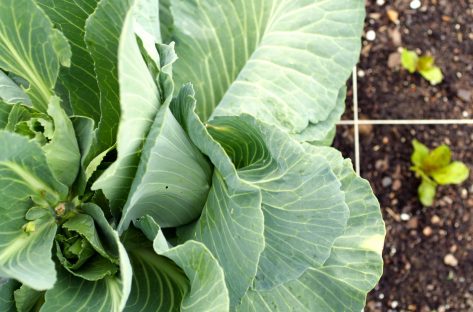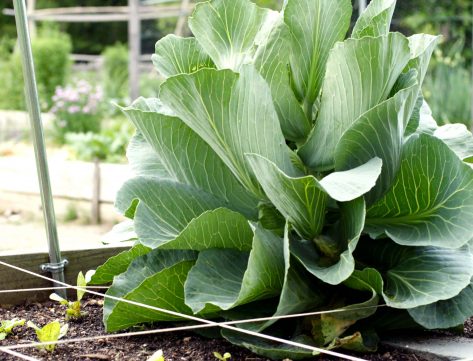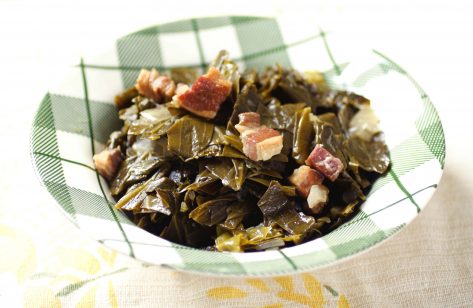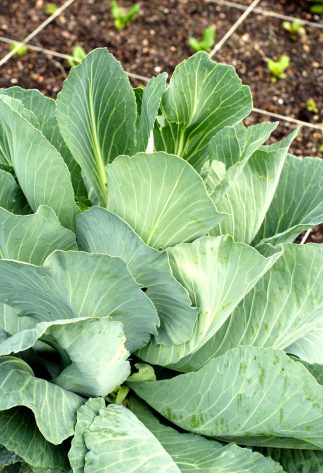Smothered Cabbage
Last weekend, when looking for a recipe to smother an unruly head of overwintered cabbage into delectable submission, I came across these can-do words in Mary Randolph’s book The Virginia Housewife Or, Methodical Cook:
It will much ameliorate the flavor of strong old cabbages, to boil them in two waters, i.e., when they are half done, to take them out, and put them into another sauce pan of boiling water.
Boy have I got one of those, I thought to myself.
The specimen I had in mind to test Randolph’s method was eight months old, and had been growing in my garden plot since last summer when I direct sowed some Early Flat Dutch cabbage seeds, hoping for a late fall harvest. I misjudged timing and gave the poor dears too late of a start to reach their cabbage potential before the first frost came—even though in Richmond, Virginia, that can be as late as late October. When it was time to prep the plot for winter, they were just one-tenth of their cabbage selves, but I didn’t have the heart to pull them up. They made it through and then, frost-bitten and wind-whipped, made up for lost time this spring, quickly becoming tall, leafy, and sculptural. Spring also put them in the mood to reproduce; in response they sent up a center stalk with seeds, which I unceremoniously removed whenever I spotted it.
“Are you sure that loose-leafed thing in the photo above really is a cabbage?”, you might ask. “It looks more like an overgrown shrub than the tidy round balls of cruciferous you see in the supermarket.”
I began to wonder the same myself when I looked at the idiosyncratic planting notes I’d scribbled down last fall in the hand-drawn gridlike map that mimics, on an inch-per-square scale, the square-foot gardening organization we use at our plot. Near to where the cabbage had been growing (or was it in the same spot?), Morris Heading Collards were penciled in. To make things more confusing, collards, generally, are sometimes referred to as nonheading cabbage and Morris Heading collards, in particular, are called “cabbage collards” by southern old-timers because they have a taste similar to cabbage and are slow to bolt.

Overwintered cabbage with this Spring’s lettuces gaining ground, though they didn’t stand a chance of catching up with their 8-month-old neighbor.
Mary Randolph does not have a method for dealing with old collards, so I couldn’t do a bait-and-switch to salvage this story. Only further research into cabbages could help me. Turns out that cabbages don’t all necessary form nice, round compact heads, not without some help and the right conditions. There are multiple factors that may encourage loose leaves that don’t form a head, among them: exposure to low temperatures (anything much below 45 degrees Fahrenheit) for extended periods of time, insufficient watering, and too much nitrogen. My cabbages experienced all of the above, including most likely the latter because peas and beans, both nitrogen-fixing plants, had been planted in the same neighborhood. Too many days of warm weather—anything much above the low seventies–can cause the same problem, but my cabbage didn’t have too many of those. So, I’m going with it. That crazy thing in the photo is a cabbage. Besides, in multiple spots up its hefty center stalk, miniature rounded cabbages leaves were doing their best to form petits choux.
*****************************************************
Randolph’s Virginia Housewife is one of the world’s most concisely written cookbooks. Twitterers have nothing on the brevity of this woman. Granted, she was able to assume a level of cooking knowledge and competence among her readers that recipe writers do not today. But within a few words she shares tidbits of cooking truths that are as useful today as they were in 1824, when her book was first published (it’s still in print, by the way). Her solution to an aged cabbage comprises nearly a quarter of her recipe for “Cabbage.” which is better described as an entry.
Okay, the cabbage is probably not the best example of a still-applicable cooking tip because today—unless you have a root cellar or mismanage your garden planting schedule—you are probably not likely to encounter a “strong old” cabbage.
We twenty-first century cooks still make homemade ice cream, though. Turn to her vanilla ice cream recipe and you’ll find this invaluable guidance:
Make it very sweet, for much of the sugar is lost in the operation of freezing.
She does not mean that the sugar disappears, literally, but that the some of the sensation of sweetness does. Having learned this fact back when I was doing research for a story on soft serve (it’s kept at about 24 degrees Fahrenheit, and as a result tastes sweeter than hard ice cream, which is stored at 0 degrees Fahrenheit or colder), this epiphany-making instruction was not news to me when I read it in Randolph’s book, but I was immediately impressed that she mentioned it.
I’ve never seen this kernel of knowledge shared in any modern ice cream recipe. Clearly Randolph was a good teacher, explaining the “whys” so her readers can become better cooks. As for her cooking, she was renowned in Richmond, Virginia, where she lived when she wrote her book, and beyond.
I love what her technique for dealing with strong old cabbage evokes: a connection with cycles of nature and a frugality based not on cheapness but seeing value in all food. Just as methods were developed to render tough cuts of meat or offal tender and delicious, so it was with those old cabbages. And Randolph is going to tell you how.
Smothered Strong Old Cabbage with Pancetta
What follows is a recipe for smothered cabbage, adapted to incorporate Randolph’s method of using two batches of cooking water to remove any bitter flavors. Popular southern preparations of cabbage, often called smothered cabbage or steamed cabbage, include a little sugar, presumably to offset the slight bitterness associated with cabbage. Randolph’s recipe for preparing cabbage doesn’t have any sugar. The addition of sugar may be a modern solution to the problem of bitterness: modern because it’s faster than doing a two-boil process. Or maybe its omission from Randolph’s recipe was just a matter of taste—that no self-respecting early nineteenth-century Virginia cook would have considered putting sugar on her vegetables. I made two batches (my old head of a cabbage was so large I had plenty to do two full recipes), both made using the same modified smothered cabbage recipe but only for one batch did I use Randolph’s change-of-cooking-water method. The difference was obvious. The preboiled cabbage, cooked in two batches of water, had absolutely no bitter flavor. With a round sweet flavor and a clean ending with no lingering bitter aftertaste, it was, compared to the other, more moreish, by a mile. The other, without the benefit of the preboil, was tasty to be sure (how can anything not be with pancetta?) but the bitter old cabbage personality hadn’t been suppressed, it was still there.
The smothered recipe I adapted is credited to Eula Mae Doré, a traditional Cajun cook who cooked for more than a half a century Louisiana’s Avery Island, where she worked in the McIlhenny Company commissary. You can find a version of the recipe online on McIlhenny Company’s site—it uses Tabasco, naturally—and another version in the recently published Southern Foodways Alliance Community Cookbook, which uses cayenne pepper.
Eula Mae’s smothered cabbage calls for salt meat, which, I believe, is salt-cured pork leg or picnic and is common in traditional Creole cooking. Reasonable substitutes are salt pork (from the belly and side), steak o’ lean, bacon, or ham hock. The butcher shop closest to me did not have salt meat or salt pork. Bacon he did have, and when I countered that I did not want a strong smoky flavor, he suggested pancetta or guanciale. I went with the pancetta. And there you have it. That’s how you end up with an Italian twist on a Southern smothered cabbage.
- 1 head cabbage, strong and old if you can get it (about 2 pounds), cored and coarsely chopped
- 3 ounces pancetta
- 1 tablespoon bacon fat
- 1 cup chopped yellow onion (about 1 onion)
- 1 scant tablespoon sugar
- ½ teaspoon apple cider vinegar
- ½ teaspoon salt
- ¼ teaspoon freshly ground black pepper
- ½ to 1 fresh or fermented medium-hot chili pepper, such as a seranno, minced (see Note), or ¼ teaspoon cayenne pepper
- Bring a large pot of water to a boil. Add the cabbage, return to a boil, then reduce the heat to maintain a rapid simmer. Cook for 30 minutes, skimming off any scum that rises to the top. Drain the cabbage in a colander and give it a rinse with cold water.
- While the cabbage is cooking, prepare the pancetta: If it has sections of fat without any visible meat, cut the fat away in long strips and render them in large heavy pot, large sauté pan with deep sides, or a Dutch oven over medium heat. While the fat is being rendered, finely dice (about ¼ inch) the rest of the pancetta, then add it to the pot along with the bacon fat. Cook the diced pancetta until it is nicely browned and crispy, then remove the pancetta (and fat strips if any) from the pot; discard the fat strips.
- Add the onion to the pan and stir it around for a bit, about 1 minute, scraping the bottom of the pan. Add the drained cabbage, 1 cup of water, sugar, vinegar, salt, black pepper, and chili pepper. Return the diced pancetta to the pot and stir to combine. Cover and cook until the cabbage is very tender but not mushy, about another 30 to 45 minutes (depending on the age of the cabbage). Taste and add more seasoning if needed.
Note: It’s a little precious to call for a “fermented” chili pepper, I know. Where are you going to find them? You’ll have to make them, probably. They are one of my latest loves in the kitchen. I made a large batch last fall with a bumper crop of serranos. They are naturally fermented with just sea salt and water, and they are wonderfully flavorful and aromatic. And overtime, their heat softens somewhat.



